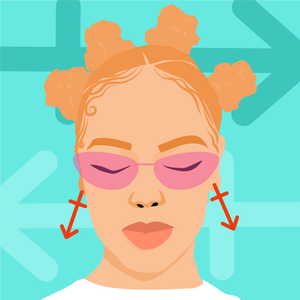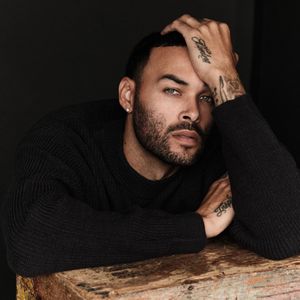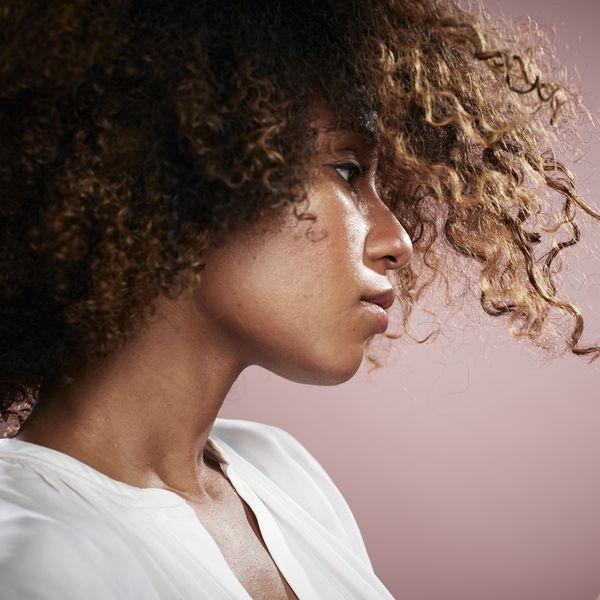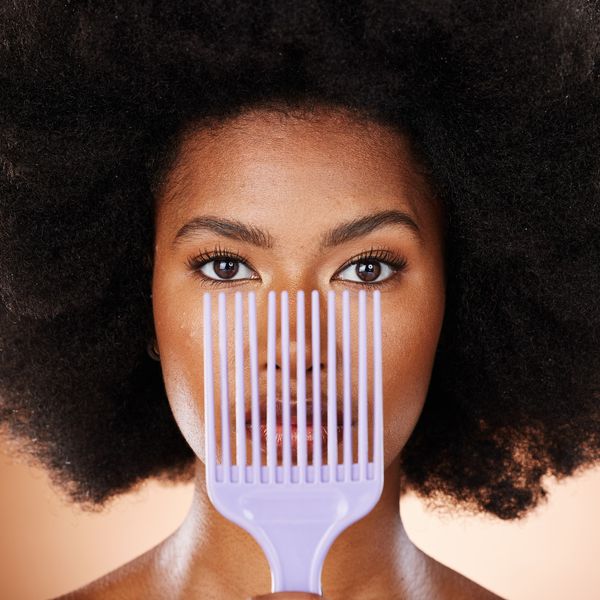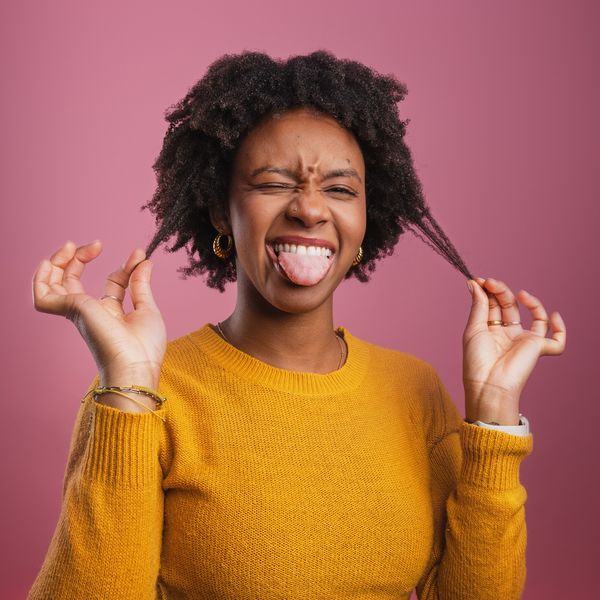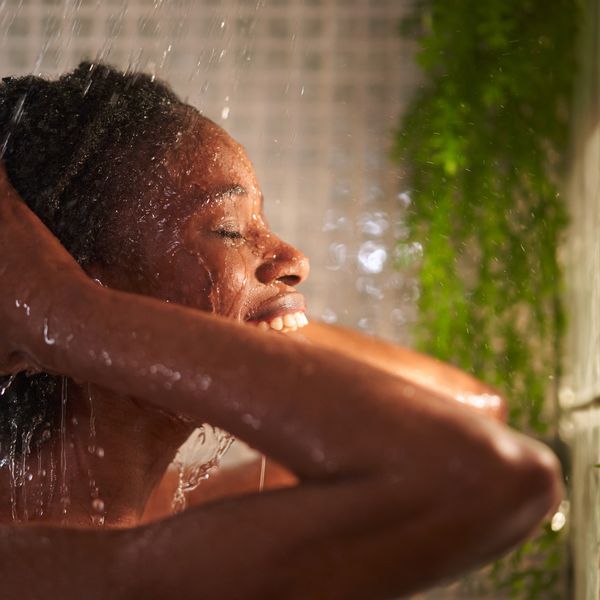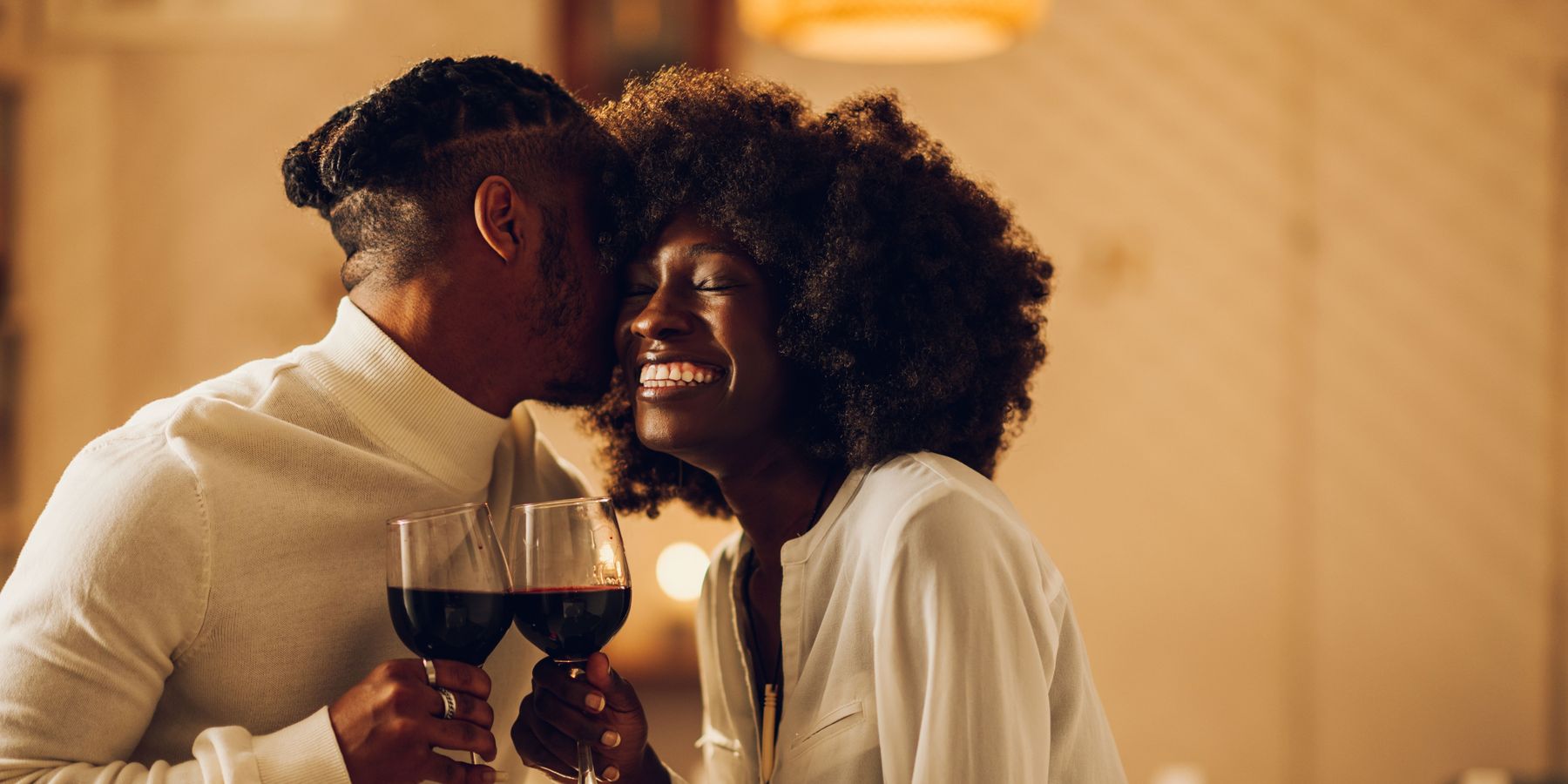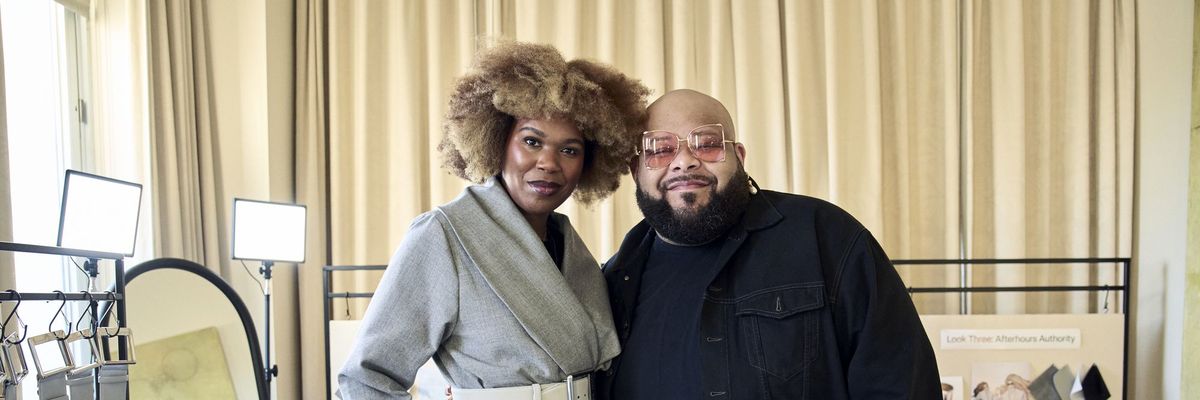
Whew, y'all. In this never-ending quest to gain some inches on this natural-haired head of mine, something that I've learned the hard way is that, while every part of our strands are important, you aren't going to get the results that you want if you're not giving the roots and the ends of your hair all of the TLC that it needs. And that is what we're going to tackle today. In order to have long and healthy hair (like YouTubers such as TheDaletiá, Janet Davies, Timaloveslemons, Maryam Hampton, All Things GhoCee and a host of others), you've got to nurture your hair follicles and preserve your ends. Here are 10 tips (five for your follicles and five for your ends) that will help to get you there.
1. Hair Follicles: Watch the Heat
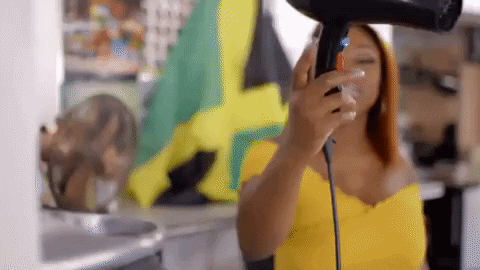
Heat is an interesting topic when it comes to maintaining the health of your hair. I say that because, I'm actually someone who does a blowout every wash day and, ever since I've added that to my hair maintenance routine, I've seen more progress. For me, the key is to deep condition, apply thermal heat protectant, let my hair dry on its own about fifty percent or so and then use a dryer on a cooler setting. Doing this keeps my hair stretched (so that it's manageable with less fairy knots and tangles) which is a good thing.
Actually, what a lot of people don't realize is heat on your hair can actually benefit your hair follicles because it helps to encourage blood flow to the scalp. What you have to be careful of, though, is not applying heat that is too hot (like putting your blow dryer on high) or using heat too often. If you do, that can actually result in permanent damage to your hair follicles (which can ultimately result in hair loss). Even if you are able to dodge that consequence, a lot of heat will almost definitely result in you having dry and brittle hair (which oftentimes leads to breakage).
2. Hair Follicles: Massage Your Scalp with a Peppermint and Thyme Essential Oil Blend
Applying some peppermint essential oil to your scalp and hair is one of the best things that you could do. It's the kind of oil that contains antimicrobial, insecticidal, pesticidal, anesthetic and anti-inflammatory properties.
Because of this, peppermint oil is able to clarify your scalp, soothe it if it's itchy and stimulate hair growth. That's because the menthol that's in peppermint oil serves as a vasodilator; that's basically a fancy way of saying that it increases blood flow to your scalp and hair follicles so that your hair can get the nutrients that it needs. As far as thyme oil goes, not only is it another oil that stimulates your hair follicles, there are studies to support that when it's combined with an oil like peppermint, lavender or rosemary, it can even treat hair loss issues like alopecia areata.
I recommend combining two tablespoons of Jamaican black castor oil or olive oil, along with five drops of peppermint oil and three drops of thyme oil. Heat the mixture up in the microwave for 30 seconds. Apply it to freshly washed hair, massage it into our scalp, let the mixture sit there for 15 minutes, then rinse with cool water. Do this once a month for optimal results.
3. Hair Follicles: Apply an Aloe Vera Mask
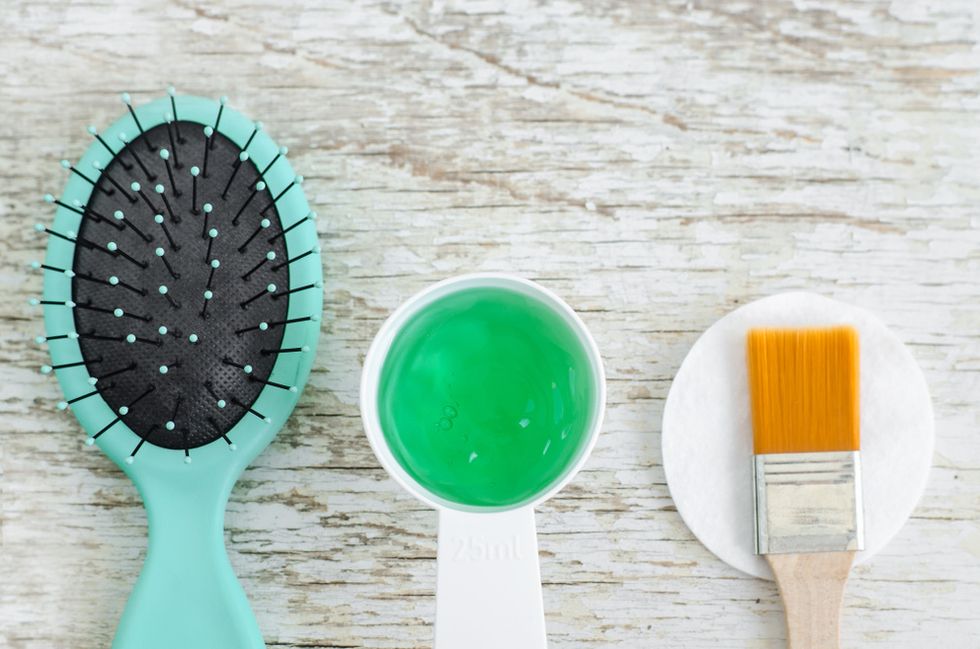
Aloe vera is great for your hair, for a few different reasons. For one thing, if you constantly struggle with having a dry scalp, the antipruritic properties that it contains can help to soothe your scalp and keep it well-moisturized. It's analgesic anti-inflammatory enzyme known as bradykinase, along with salicylic acid, work together to reduce any inflammation that your scalp or hair follicles may be experiencing (this includes if you're someone who happens to get scalp acne). Something else that's cool about Aloe vera is it helps to balance out the pH of your scalp (more on that in a little bit). And yet, one more reason why you should add it to your hair care regimen is Aloe vera is a wonderful treatment for your hair follicles. Because the make-up of Aloe vera is very similar to keratin, when you apply it to your scalp, it has the ability to naturally strengthen your hair follicles. Not only that but the 20 different amino acids that Aloe vera contains will help to condition and strengthen your hair so that the roots of your tresses are healthy from the very moment they grow out of your scalp. That's why it's a good idea to apply an Aloe vera mask to your scalp, at least once a month. For tips on how to make your own, click here and/or here.
4. Hair Follicles: Detox Your Scalp
Sometimes, we forget that our scalp has pores, just like the rest of our body does. And, because a lot of us use hair products (not to mention the fact that we sweat and our scalp sheds dead skin cells), those pores can become clogged which can also lead to a slower rate of hair growth. A surefire way to keep your scalp healthy and thriving is to detox it. If you'd like more info on how to do that properly, no problem. You can check out an article that I already wrote on it. It's entitled "Treat Your Scalp To A Little Bit Of Detoxing This Weekend".
5. Hair Follicles: Eat More Protein

Have you ever wondered if you actually need more protein in your system than you're currently getting? Some signs that you could indeed be protein-deficient is you constantly feel weak or tired, you're always hungry (no matter how much you consume), you're always getting sick, your moods are all over the place and/or your skin, nails and hair don't seem as healthy as they usually do. Speaking of hair, yours is made up of mostly protein (keratin), so you definitely need to "feed your follicles" with foods that are loaded with it. Some of those include red meat and poultry. But if you happen to be vegetarian or vegan, some non-meat alternatives include lentils, pumpkin seeds, oats, almonds, quinoa, spinach and spirulina.
1. Your Ends: Balance Your Hair’s pH Balance
When it comes to what pH balance actually is, it's kind of a long story. The short of it is, it's the measure of how acidic and/or base something else. When something has a pH balance of 7, it's considered acidic. When something has a pH balance of 4, it's considered base. When it comes to our hair, its average is somewhere around 5. Something that can throw our normal pH balance off is shampoo, conditioner and other hair products. The problem with that is an "off balance" can lead to rough hair cuticles and, eventually, hair damage.
Something you can do to keep your hair's pH balance right where it needs to be is to clarify your hair with an apple cider rinse. Not only will it bring the balance back to where it should be, but apple cider vinegar also contains anti-fungal and antibacterial properties that can treat dandruff and other scalp irritants. Plus, it is able to make your hair softer and easier to manage. Just add a tablespoon of apple cider vinegar to a cup of water and pour it over your hair after shampooing in order to get the best results.
2. Your Ends: Seal ‘Em
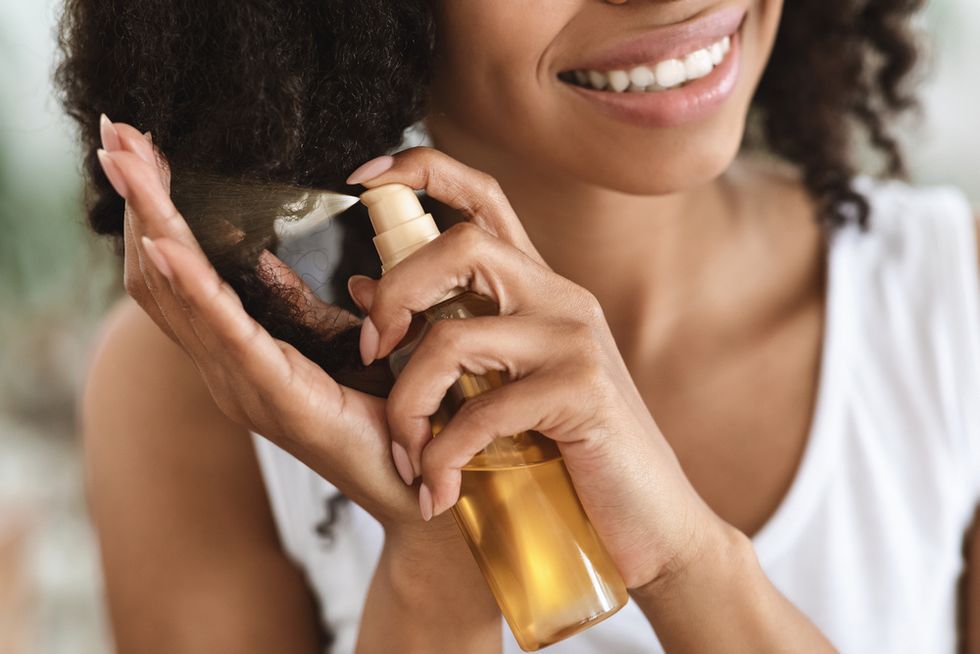
Sealing ends is something that a lot of naturalistas know about. It's a process that helps your hair to maintain the moisture that is already in it, after you wash and condition your tresses. Because your ends are the oldest part of your hair, that makes them the most vulnerable. It also means they need moisture the most. That's why it's important to seal your ends in two ways. One, you should do the final rinse of your hair with cool water. The reason why is because a colder temperature can actually help to flatten and seal your hair's cuticles. Next, you should apply some sort of hair butter (like shea butter) or oil (like Jamaican black castor oil) to your hair while it is damp. By the way, a "sealant" that a lot of people rave about is good old-fashioned hair grease. If that sounds bananas to you, check out "Looking For Hair Growth? It Might Be Time To Bring 'Blue Magic' Back". The lead picture alone, just might make a believer outta you.
3. Your Ends: Use a Leave-In Conditioner
I'm one of those women who, no matter how much I deep condition my locks, my hair is gonna feel dry as the Sahara two days later, and dry tresses will definitely lead to breakage over time. What changed the game for me was putting a leave-in conditioner on my hair. There are a few benefits that come from doing this. It deeply moisturizes your hair. It helps to keep your cuticles nice and smooth. It can provide an extra layer of protection from heat styling tools as well as outdoor elements. And, my personal favorite, it can help to condition your hair for days on end. Hair that contains moisture is hair that is able to remain strong with a good amount of elasticity to it. So, definitely make it a point and practice to use a leave-in on a regular basis. What I use is Aunt Jackie's Quench – Moisture Intensive Leave-In Conditioner (I haven't encountered a better leave-in yet!). But there are plenty of others on the market. Or, you can make your own (check out some recipes here, here, here, here and here).
4. Your Ends: Dry Your Ends the Right Way
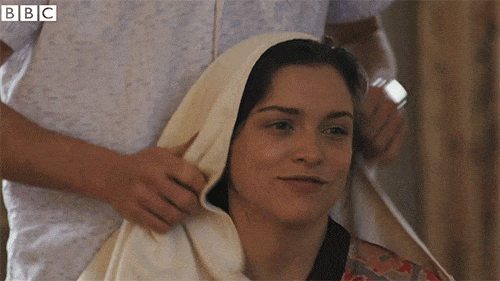
If you're someone who, after washing and conditioning your hair, you towel dry, maybe blow dry, and then simply go on about your business without giving any of that much thought, this could be why your ends are not as healthy as they should be. For starters, our hair is strong-yet-fragile (especially when it's wet), so it's best to use an old T-shirt to dry it rather than a towel. Otherwise, you could cause already opened cuticles to crack and your hair to become frizzy. Also, as much as possible, try and move your T-shirt in a downward motion on your hair so that the tee moves in the direction that your cuticles should be going (which is also downward). Same goes for blow-drying your hair. By pointing your dryer's nozzle (or using the comb attachment) in a downward position, that will help to flatten your hair's cuticles, making them less susceptible to damage until your next wash day.
Your Ends: Dust, Don’t Pull, Your Ends
In the quest for length retention, I get it if one of the last things you want to do is put a pair of shears to your hair. But if you don't trim your ends on a consistent basis, it can lead to tangles, split ends, a lack of shape or volume and, your hair actually not growing as fast as it could—or should. It's not because trimming your hair helps your hair to grow faster; it's that, by making sure that your ends aren't raggedy, that can prevent breakage. After all, if your hair is growing at the roots, but is constantly breaking at the ends, you're not gonna get the inches that you're looking for.
No one said that you had to get a professional trim, every 4-6 weeks. Matter of fact, stylists who aren't haters (you know what I mean, the ones who actually support you growing out your hair instead of always taking five inches off each visit) will tell you that every 4-6 weeks may not even be necessary. So long as your hair doesn't show any of the signs that I've just mentioned, you can probably go much longer without needing a trim appointment. Just make sure that you do consider dusting your ends from time to time. That's like doing a micro-trim where you use your own pair of shears to get rid of any split or damaged ends that you might see. If you do happen to notice some, always cut, don't pull. Pulling the ends of your hair, even if they are fairy knots, is a sure way to harm your hair's cuticles and create split ends in the process. If you'd like a few tips on how to properly dust your ends, click here.
Hopefully, this has given you a little more insight into how to reach your own hair goals. Just remember that, as long as your hair is actually growing, you can obtain length. It's all about taking the best of care of your hair—top and bottom. From the roots down to the very ends.
Want to talk more about beauty, wellness & self-care with like-minded women? Join the xoTribe members community today to start your glow-up journey.
Featured image by Shutterstock
- How To Avoid Heat Damage - xoNecole: Women's Interest, Love, Wellness, Beauty ›
- Best Drinks For Healthy Hair Growth - xoNecole: Women's Interest, Love, Wellness, Beauty ›
- What Is Dandruff? - xoNecole: Women's Interest, Love, Wellness, Beauty ›
- Expert Tips To Prevent Hair Breakage - xoNecole: Women's Interest, Love, Wellness, Beauty ›
- 9 Tips For Long Hair And Home Remedies To Strengthen The Roots ›
- 10 Ways to Actually Make Your Hair Grow - Restore Hair ›
- Weak Hair: Signs, Causes & 6 Ways To Strengthen It – SkinKraft ›
- The Ultimate Hair Checklist to Strengthen Roots | Viviscal Healthy ... ›
- Tips on How to Strengthen Weak Hair | Matrix ›
- How To Strengthen Your Hair Roots Through Ayurveda? – Vedix ›
- How to Strengthen Hair: 10 Tips and DIY Treatments ›
This Is How To Keep 'Holiday Season Stress' From Infecting Your Relationship
Hmph. Maybe it’s just me, but it seems like there is something really weird happening in the fall season air (because winter doesn’t officially begin until December 21) that cuddle season is in full swing while break-up season is as well. In fact, did you know that break-ups are so popular during the holiday season that December 11 is deemed Break-Up Day?
The reasons why relationships shift around this time vary; however, I did both roll my eyes and chuckle when I read that a very popular one is because it’s an easy way to get out of getting one’s significant other a Christmas present. SMDH.
Anyway, I personally think that the less shallow folks out here may contemplate calling things “quits” or they at least distance themselves a bit from their partner (and what I’m referring to is serious relationships) due to all of the stress and strain that oftentimes comes with the holidays whether it be financial, familial, due to their tight schedules or something else.
Listen, I would hate for you and your man to miss the fun and happiness of experiencing this time of year, all because you are so overwhelmed or irritated that you can’t really enjoy it. That’s why I have a few practical tips for how to avoid allowing the typical holiday season stress from INFECTING your relationship.
Manage Your Expectations
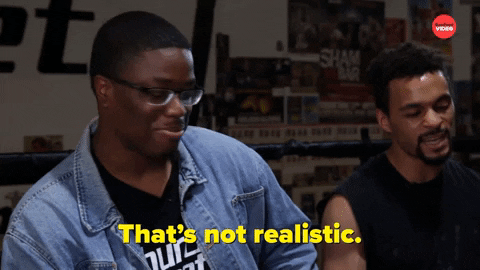 Giphy
GiphyUnmanaged expectations. If there is a main reason why the holiday season tends to be so stress-filled for so many people, I’d bet good money that this is the cause. And when you’re in a long-term relationship, expectations can manifest themselves in all sorts of cryptic and/or unexpected ways. You might have relatives who assume that you are going to be with them for Thanksgiving or Christmas when you have other plans in mind. You might be thinking that you are going to spend one amount for presents while your man is thinking something totally different. When it comes to scheduling, your signals may be crossed.
And you know what? To all of these scenarios, this is where clear and consistent communication come in. Don’t assume anything. Don’t dictate anything either. From now until New Year’s, mutually decide to check in once a week, just to make sure that you are both on the same page as it relates to the holidays and what you both are thinking will come along with it. The less blindsided you both feel, the less stressed out you will be. Trust me on this.
Set (and Keep) a Budget
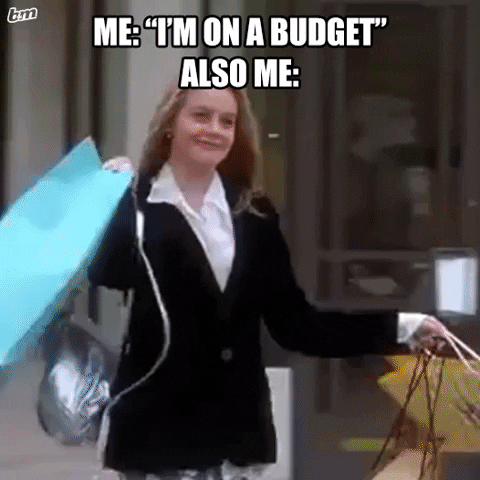 Giphy
GiphyOkay, so I read that last year, 36 percent of Americans incurred some type of holiday-related debt. Hmph. Last year, there was still some sense of normalcy in this country, chile, so I can only imagine what finances are gonna look like over the next several weeks. That said, since I don’t know a lot of people who don’t find being broke stressful, make sure that you and your bae set a budget and then stick to it this year — no ifs, ands or buts.
Because really, y’all — it doesn’t make sense to deplete savings and/or max out credit cards for a few days of giggles only to be damn near losing your mind because you don’t know how to make ends meet come Dr. Martin Luther King, Jr. Day.
And by the way, this tip doesn’t just speak to things like food and gifts; I also mean travel. If it doesn’t make a ton of sense (or cents) to be all over the place this year — DON’T BE.
Keep Matthew 5:37 at the Forefront
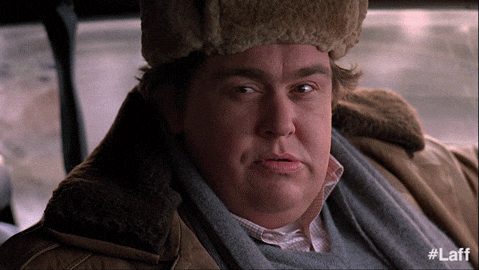 Giphy
GiphyIf off the top of your head, you don’t know what Matthew 5:37 says, no worries, here ya go: “But let your ‘Yes’ be ‘Yes,’ and your ‘No,’ ‘No.’ For whatever is more than these is from the evil one.” That verse right there? Oh, it’s a boundaries lifesaver! I say that because do you see “maybe” or “I’ll think about it” in there? Nope. LOL. It says that you should tell people “yes” or “no” and leave it at that — and that complements Anne Lamott’s quote, “’No’ is a complete sentence” impeccably well. Yeah, you’ve got to remember that anything beyond a yes or no to a request is privileged information; you don’t owe anyone details or an explanation.
Besides, if you are really honest with yourself, when someone asks you something and you give a “Umm, let me think about it” kind of reply, more times than not, you already know what your answer is going to be — so why not let you both off of the hook? Give your response. Commit to that. And let everyone (including yourself) get on with their lives and schedules.
I promise you that when it comes to those holiday parties, you are pissing more folks off by not RSVP’ing or doing so and not showing up than just saying, “Thank you but not this year” off the rip.
Remember That Your Personal Space Is Privilege Not a Right
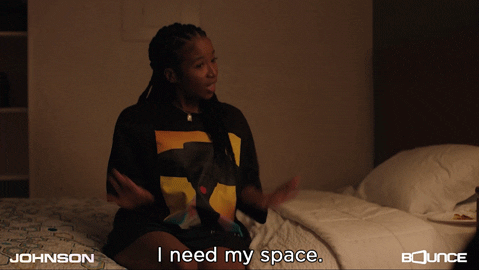 Giphy
GiphyA friend of mine recently bought a new house and invited me over to come see it. He’s a single man with no children, so as I was taking in all of the space that he had, especially as I walked through his finished basement, I joked about relatives coming to live with him. “Hell no” and “absolutely not” were pretty much his immediate responses as he went on to say that some folks even had the nerve to be offended when he told them that he had no intentions on taking DNA in.
Ain’t it wild how people think that your stuff is their right? And yes, that brings me to my next point. Your home is your sanctuary space. If you want to host folks this year — cool. If not, ALSO COOL. Please don’t let folks (family included) guilt you into how they want you to act or even into what they would do if the shoe was on the other foot. You are not them — and as one of my favorite quotes states, “If two people were exactly alike, one of them would be unnecessary.” (A man by the name Larry Dixon said that.)
Hell, my friends? They know that I am good for sending them random things that they need or even want all throughout the year. Coming over to hang out at my pace, though. Uh-uh. Chalk it up to being a card-carrying member of the ambivert club yet I like keeping my living space personal — and I sleep like a baby, each and every night, for feeling that way.
Always remember that your space, your time, your resources, your energy and shoot, yourself period (including your relationship), are all things that are your own. You get to choose how, when and why you want to share them. The holiday season is certainly no exception.
Cultivate Some “You Two Only” Traditions
 Giphy
GiphyIt’s not uncommon for some couples to hit me up after the holiday season to “detox.” Sometimes it’s due to the financial drama (and sometimes trauma) that they experienced. Sometimes it’s because they allowed their relatives (especially in-laws) to get more into their personal business than they should’ve. More than anything, though, it tends to be because they didn’t get enough quality time together and so ended up feeling “disconnected.”
Please don’t let that happen. Listen, I’m not even a holidays kind of woman and yet, I will absolutely sit myself down with some hot chocolate and chocolate chip cookies to enjoy a Hallmark holiday film or two. Aside from the fact that most of them are lighthearted and sweet, I also like that they usually focus on couples loving on each other amidst all of the holiday beauty and ambiance — which is something that all couples should set aside some time to do.
Maybe it’s a vacation. Maybe it’s a staycation. Or maybe it’s my personal favorite, A SEXCATION. Whether it’s for a few days, the weekend or even overnight — don’t you let the holidays go by without setting aside time for you and your man to celebrate one another. Don’t you dare (check out “Are You Ready To Have Some Very Merry 'Christmas Sex'?”).
GET. SOME. REST.
 Giphy
GiphyI once read that 8 out of 10 people get stressed out over the holidays and 3 out of 10 lose sleep during to it — and when you’re stress-filled and sleep-deprived, that can absolutely lead to hypersensitivity, making mountains out of molehills and even not being in the mood for sex.
Your relationship can’t afford to go through any of this, so definitely make sure to prioritize rest. I don’t care how unrealistic it might seem during this time, sleep should never be seen as a luxury; it will always and forever be a great necessity.
That said, try to get no less than six hours of shut-eye in (check out “6 Fascinating Ways Sex And Sleep Definitely Go Hand In Hand”) and even ask your bae to take a nap with you sometimes (check out “Wanna Have Some Next-Level Sex? Take A Nap, Sis.”). Not only will sleep help to restore your mind, body and spirit but, when it’s with your partner, it’s an act of intimacy that can make you both feel super connected, even in the midst of what might feel like chaos.
___
Holiday season stress is real. Still, never give it the permission or power to throw your relationship off. Put you and your man first and let the holidays be what they are gonna be, chile.
Let’s make things inbox official! Sign up for the xoNecole newsletter for love, wellness, career, and exclusive content delivered straight to your inbox.
Featured image by Shutterstock
Sergio Hudson On Designing With Intention And Who Gets Left Out Of The Industry
Sergio Hudson dreamt big as a young South Carolina boy staring out of the window of his mom’s Volvo driving down the Ridgeway, South Carolina streets. Those dreams led him to design opulent tailoring that’s been worn by Beyoncé, Queen Latifah, former Vice President Kamala Harris and Forever First Lady Michelle Obama, just to name a few.
Those dreams have come full circle in a new way as he recently collaborated with Volvo for a mini capsule collection suitable for chic and stylish moments this fall. The 40-year-old designer follows a long legacy of fashion aficionados who’ve used their innovation to push the automotive industry forward, including Virgil Abloh, Eddie Bauer, Paul Smith and Jeremy Scott.
Using the same material from the interior of the Volvo EX90, Hudson crafted a wool-blend car coat and waistbelt that combine the vehicle’s Scandinavian design with his signature tailoring and intention. The exclusive collection launched on October 20, and each piece is made-to-order by Sergio Hudson Collections.

Courtesy
In October, I traveled to Charleston with a group of journalists to get a firsthand look at Hudson and Volvo’s location. During a fitting, Hudson said his goal is to make “great work that can stand the test of time.”
“People can look back on and say, ‘I remember when Sergio did that collaboration with Volvo,’” he continued. “Thinking about aligning yourself with classic brands that speak to where you want to go. And I think that's what this collaboration kind of means to me and my business.”
Hudson pinpoints his mom as the biggest influence for his designs. This collaboration was no different.
“This particular coat reminded me of the swing coats that my mom used to wear in the early 90s. You know, diva girls in the early 90s had Sandra suits,” he said, referring to Jackée Harry’s character in 227. “My mom wore those and she would have these matching swing coats to go over them. And that's where the initial idea came. This would be around the same time that we had our Volvo. So she would put on her suit, her swing coat, get in that red Volvo, and go to church.”
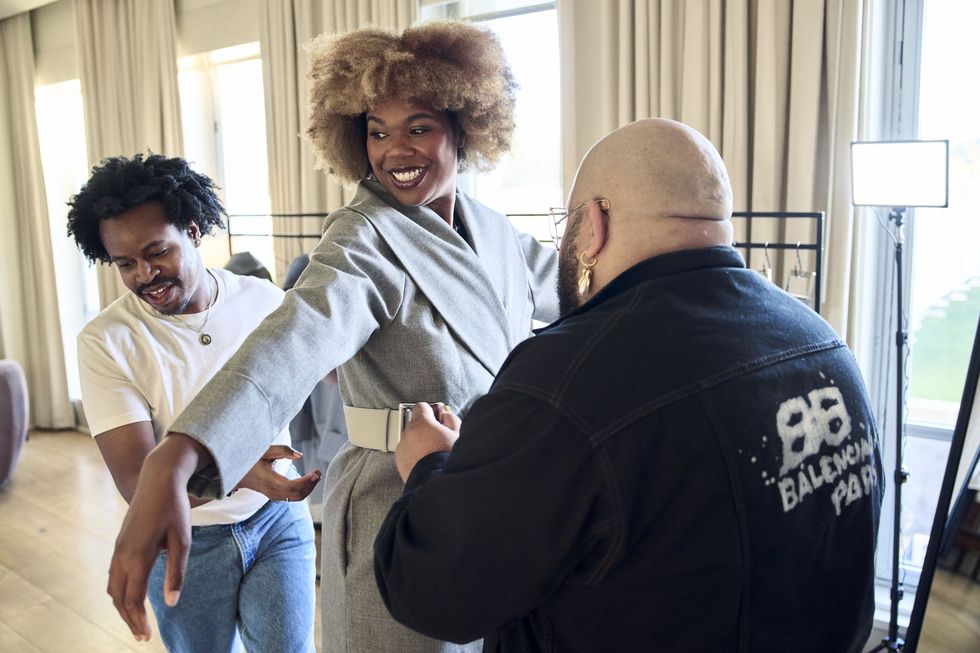
Courtesy
With this capsule and beyond, Hudson wants to see more staples rotating in and out of closets this fall. He advises fashionistas to build her closet out with essentials to mix and match that aren’t just stylish but also sustainable.
“It's just those special pieces,” he said. “You can wear the same shirt and pants every day and nobody will notice. But if you have a special boot, a special coat, a special bill, a special bag, that kind of speaks to everything that your style stands about, that is something you should focus on.”
These are the same kind of staple pieces that return to our Pinterest boards and TikTok feeds season after season. Fast fashion has never been Hudson’s aim. “I'm trying to create a special pieces that can stand the test of time,” he said in his warm, Southern accent. “I'm only creating those kind of pieces from here on out.”

Courtesy
For Hudson, this collaboration is revolutionary. It’s his first time working with a car company and experimenting outside of his wheelhouse in this way.
“This is a Scandinavian brand, and, you know, it's 70 years old. I'm an African-American boy from South Carolina that has had a brand for 10 years. So I think bridging those two worlds and seeing the similarities was the beauty of this project,” he explained.
Though Hudson and his partner and CEO of Sergio Hudson Collections Inga Beckham have made massive strides in just 10 years, Hudson said the industry is far from where he wants to see it when it comes to Black representation. He pointed to how few Black designers were at this year’s Met Gala despite the theme being Black dandyism.
“The fact that I dressed 18 people speaks to how many of us weren't there,” he said. He implored more of industries, fashion and beyond, to collaborate with Black designers often.
“Allow mentorship. Allow funding. Allow great design to shine through,” he implored. “When it comes to being a designer of African descent, when you can't get the funding that your counterparts have, you can't compete. When you get opportunities like doing a collaboration with Volvo, or you get opportunities to be at the Met Gala, that's putting us on the equal playing field, but really the funding behind it is what we need to take it to that desk level.”
Featured image courtesy

